Rottweiler: breed characteristics and keeping rules

Among dog breeders, the Rottweiler is considered an intelligent, loyal and well-trained pet. He receives many awards at exhibitions, is considered a universal dog used in law enforcement agencies. However, this creature, with all its impressive appearance, can become the best friend and guardian. The material in this article will be useful to those readers who want to have such a puppy, but do not know all the nuances of the breed.

Origin story
Modern Rottweilers are attributed to dogs of German origin, the history of their appearance goes back to the distant past. The ancestors of the Rottweilers, who are considered to be mastiff-like dogs and molossians, lived in Ancient Egypt, Babylon and Assyria. Someone thinks that the Neapolitan Mastiffs also took part in the development of the breed. Someone points to ancient bas-reliefs and frescoes depicting dogs that are very similar to modern Rottweilers.
No matter how different opinions about the origin, the ancestors of strong dogs were hardy animals that were used in war, as well as for guarding and grazing livestock... In the war, they were used against enemy infantry. Julius Caesar testified to this, saying that the ferocity of these animals made them a universal weapon.
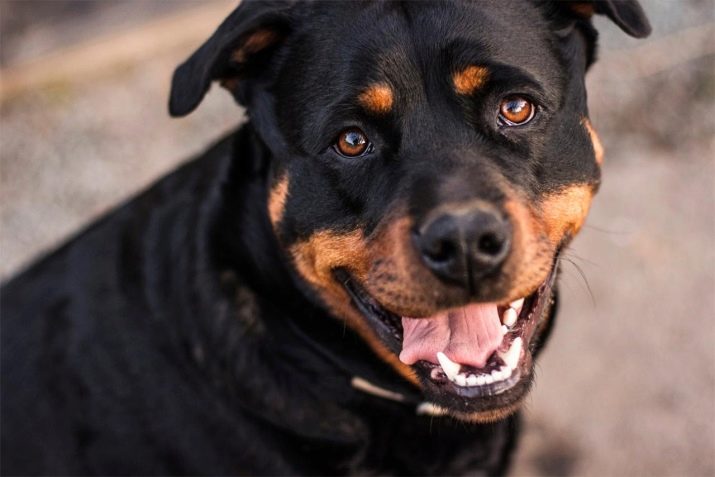
These dogs were also appreciated during the Roman Empire, from the middle of the 1st century they began to be used in gladiatorial battles.
People, thirsty for bloody spectacles, appreciated dogs for the power with which they dealt with predators exceeding them in size. Hundreds of the best developed dogs began to accompany the Romans on their campaigns, which terrified enemies. It was this that began to contribute to the spread of the range of animals in all possessions of the empire. Dogs not only accompanied the military, but also guarded trophies, led animals from battles, served as butchers to guard goods.
Remarkable is the fact that at that time dogs were raised in different ways. Some of them underwent special training, after which they became a formidable weapon. The legionnaires had a special approach to military equipment, and therefore, before the attack, the dogs were chained in armor and only after that they were allowed to advance on the enemy. Rottweilers never gave up in battle and preferred to fight to the death rather than retreat.
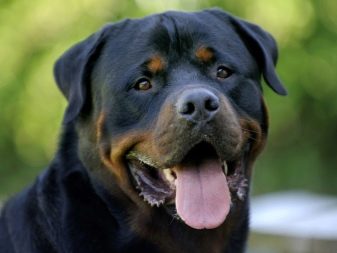
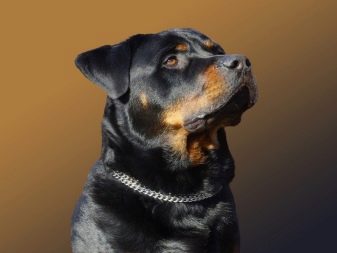
These fighting dogs got their name from the port city of Rottweil, which was famous for its food trade. Here they began to breed their own breed of dogs, paying special attention to protective qualities and accompaniment.
In the Middle Ages, these animals were divided into 2 types: with massive and typical croup. Dogs of the first type were the guards of warehouses and dwellings, and they were also used as a draft force for transporting various goods.
but the outstanding size made the dog not so versatile for hunting, while its stamina also suffered... And the bite of such an animal could seriously injure not only a goat or a sheep, but also cows and bulls. Less heavy dogs differed from their counterparts in better indicators of mobility and endurance. It was they who began to be appreciated by herders for the best protective qualities and livestock management.
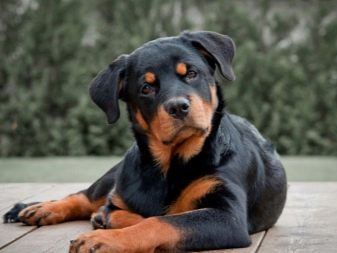
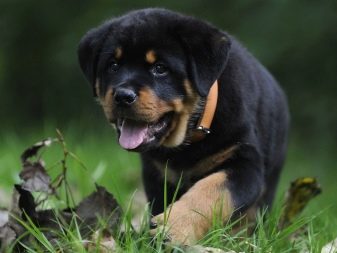
These dogs could knock down arrogance from overly aggressive bulls and drunken people.
They often had collars with special compartments for money, which saved owners from theft and attacks when selling livestock at fairs. The fame of the Rottweilers frightened every hunter to other people's money and protected not only the proceeds: sometimes these dogs saved their owners. Over time, due to the ban on driving livestock, the number of Rottweilers began to decline. These events peaked in the 19th century.
The decisive factor that determined the fate of the Rottweilers was the interest of the police in them. At the very beginning of the 20th century, the German press was buzzing about how the Rottweiler of the sergeant of the Stuttgart police in a matter of minutes resolved the conflict of the sailors on a spree, turning them to flight. It was thanks to this event that popularity returned to the Rottweilers, and therefore special attention was paid to breeding the breed. After 20 years (in 1921), the dogs have already acquired their own fan club.
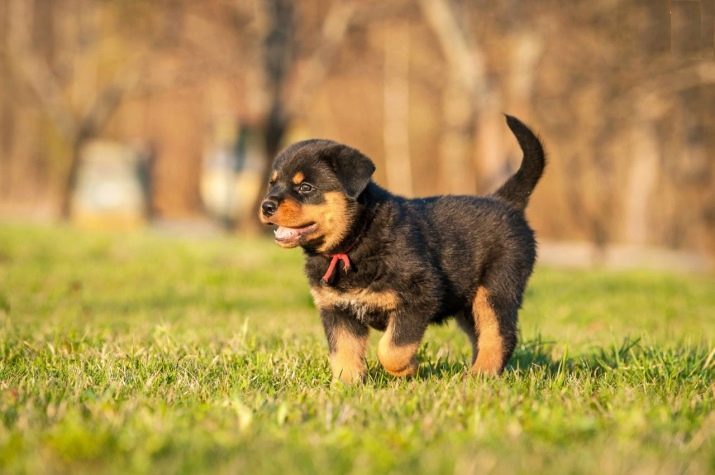
During the war, Rottweilers were entrusted with the protection of secret facilities.
In Prague, they dragged harnesses with coal to the houses from the station. It was they who guarded the prisoners of the Gulag, and the Soviet breeders made a lot of efforts to create the most brutal guards out of the Rottweilers. As a result, the dogs became instruments of murder and earned a bad reputation.
The breed received a new round of development in the 80s of the last century.... At this time, a Rottweiler Harras Steinkopf was brought to the USSR from Germany. His character was radically different from the character of those dogs that were bred in the USSR. He was a smart, tall, handsome man who did not rush at people, but obediently obeyed the owners. It was also surprising that he was reasonable, devoid of any ferocity and inexplicable aggression.
From that moment on, the breeders' view of the Rottweilers began to change, as did the character of the dog.

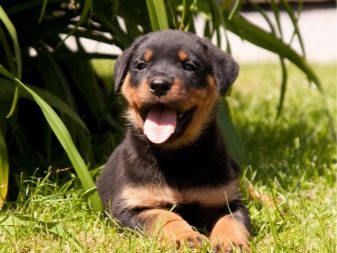
Today, representatives of the breed serve in rescue teams, looking for people in the rubble after earthquakes.
They are companions of people, and many of them get along very well with children. However, in order for a dog to grow up kind and peaceful, you cannot do without training.
Description of the breed
Rottweilers are attentive, strong-willed animals with excellent service qualities. Dogs have well-developed muscles. The purebred dog looks big and formidable, others are afraid of him.
The height and weight characteristics of Rottweilers are as follows: the average weight of a dog is about 50 kg, while the weight of a bitch usually does not exceed 42-45 kg. The range of height at the withers in a dog varies from 61 to 68 cm.
In bitches, the height at the withers is less and usually is about 56-60 cm.However, especially large females can be taller: their height at the withers reaches 63 cm. The standard length of an adult dog is considered to be from 118 to 132 cm.
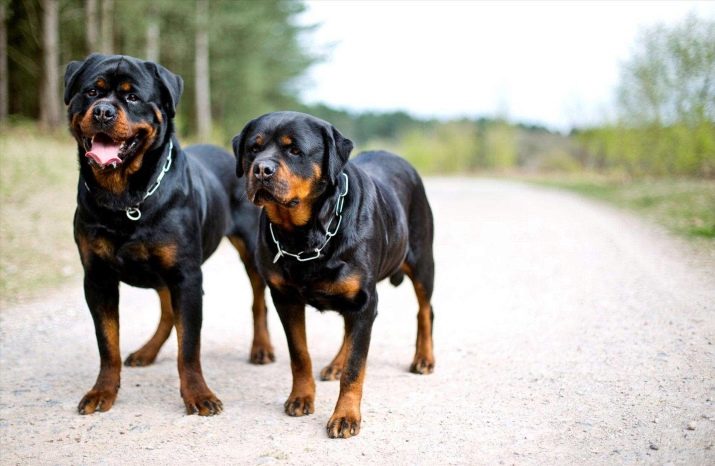
However, these indicators can change, but you can still track the proportions. In these dogs, they are always preserved and are equal to the ratio of 1: 2 (height to length).
Rottweilers belong to the group of Schnauzers and Pinschers, Molossians and Swiss Mountain Dogs. These are dogs with their own exterior standard. Their constitution is neither bulky nor lean: it is balanced. The body is compact, but powerful, its length from the point of the sternum to the ischial tuberosity usually does not exceed the height at the withers by more than 15%.
The skin is smooth, with a tight fit on the head, and has no folds. They can form on the head only when the animal is very alert. The skull of these dogs is moderately long, wide between the ears. The frontal line is moderately pronounced, the occipital protuberance is sufficiently developed, the stop is pronounced.
The muzzle is in proportion to the skull, it is neither elongated nor short, the ears are set wide apart. The bridge of the nose is straight and wide, moderately narrowed towards the end. The nose is black, moderately wide, and has large nostrils. The lips are snug, their corners are closed, the gums are dark in color.

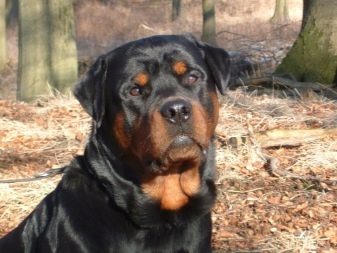
The bite of a thoroughbred representative of the breed is scissor-shaped, the dental formula has 42 teeth.
At the same time, there are 20 teeth on the upper jaw of the dog, at the bottom of them there are 22. The size of the eyes of a Rottweiler is average, their color is dark brown. The shape of the drooping ears tends to be triangular, their size is small, with the upper edge of the skull, they form a straight line.
The neck of these dogs is muscular, slightly arched, and moderately long. The loin is short, the croup is round, the chest is deep, the bone is massive. The groin area of these dogs is tucked up.
The limbs are straight, the thighs are characterized by well-developed muscles. The paws themselves are rounded, compressed into a lump, the paw pads are elastic. The hind legs are longer than the front ones; the nails of these dogs are not long, but rather strong. The tail is extended, continuing the upper line of the back.
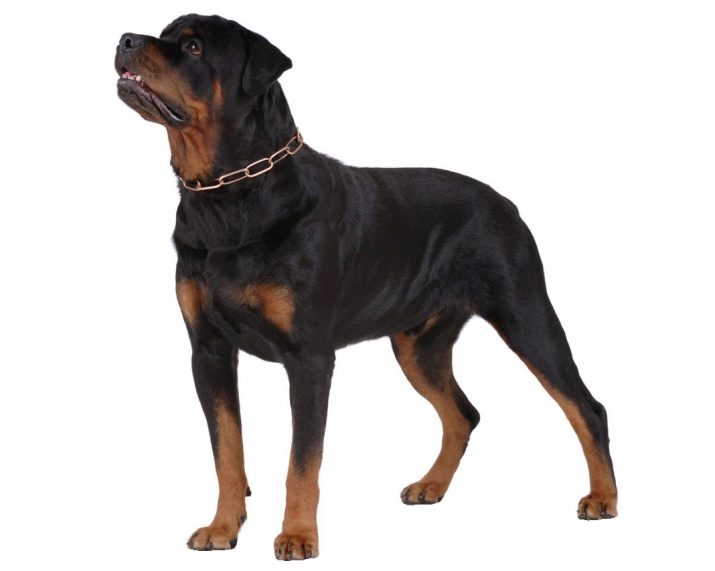
Despite the fact that the standard implies its docking, as well as ear docking, today not every Rottweiler breeder performs this procedure.
As for wool, it has its own characteristics. Its texture is uniform, the covering wool itself is quite tough and rough to the touch, tight-fitting. The undercoat of a thoroughbred of the breed is dense, but short. The hair on the hind legs is longer.
According to the requirements of the standard, the coat of these dogs should be of medium length, lying flat. In this case, the undercoat should not be visible. There can be only one color in Rottweilers: black wool with reddish tan marks. Singles can be located in the areas of the cheekbones, eyes, paws, perineum, throat.
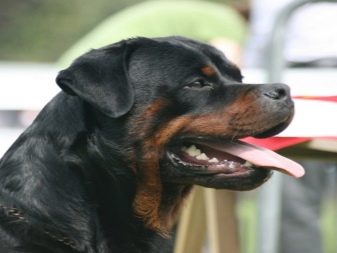
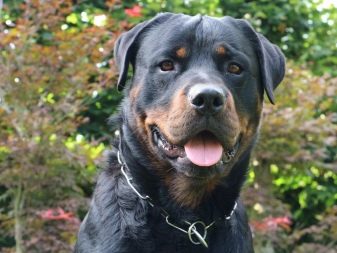
Moreover, they must be symmetrical. The standard does not allow any light or white spots in the color.
Dogs are disqualified for several reasons, for example, because of:
- increased aggressiveness;
- excessive excitability;
- cowardice and indecision;
- wrong bite;
- incomplete dental formula;
- long coat or waviness.

Life span
The life resource of Rottweilers is on average 8 to 12 years. However, these indicators can vary depending on the diet and lifestyle of a particular animal. There are cases when dogs of this breed lived up to 14-15 years with good care. As for the facts of life expectancy up to 17 years, this is rather an exception than a rule.
The following aspects can also affect the duration of the life cycle:
- the ecological background of a particular region;
- lack of vitamins and minerals;
- lateness of preventive visits to the veterinarian;
- lack of necessary vaccination.
In addition, the breeder's attitude towards walking affects the life span of an animal. Much depends on how much fresh air is enough for the pet, how it throws out its energy on walks, whether it combines them with physical and mental stress.
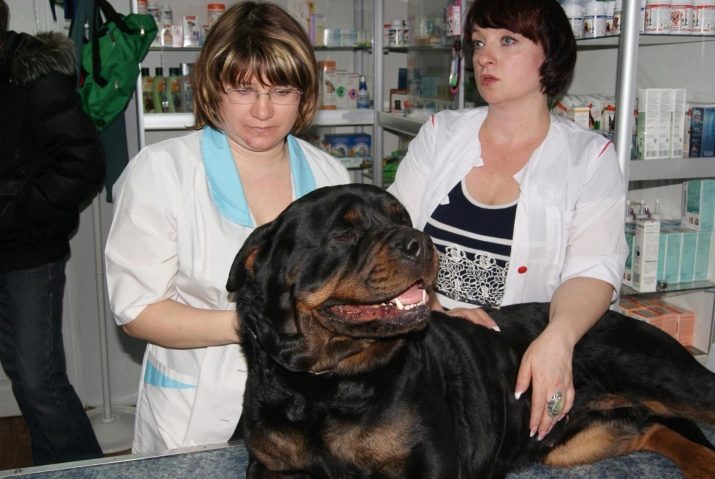
A dog whose owner is too lazy to devote a lot of time to the pet is deprived of the possibility of physical development, and therefore its unspent energy develops into aggression.
If the dog begins to rush at the owners, he has to be put to sleep.
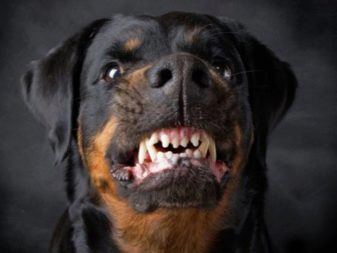

Character
It is not for nothing that Rottweilers are considered fighting dogs: they can really be called natural-born fighters. They are ready to defend and protect their masters at any time of the day, although in an informal setting they instantly turn into a charming bumpkin. They are not alien to fooling around in the company of household members, taking a nap, playing and even being mischievous.
but if the dog at home seems cute and fluffy, outside the home its character often changes radically... This partly depends on the owner, who cannot train and raise the pet correctly. Therefore, as soon as a dog is on the street, each person often becomes a potential threat to it. At the same time, no matter how much the breeders claim that their pet is kind and affectionate, a large number of Rottweilers do not make age discounts.
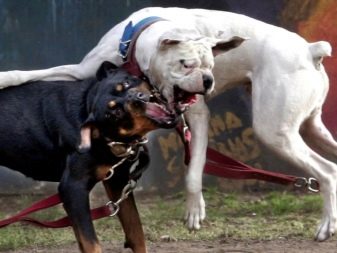
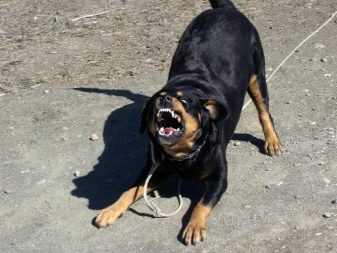
The best qualities of a Rottweiler will not extend to either an adult or a child if it is an outsider or not a member of the family.
Despite the fact that the animal has the ability to adapt, it is often does not tolerate a change of owner... And in general it is a dog of one owner. When it changes, animals can become depressed, some rush into the run, and still others show uncontrollable aggression at all.
Some members of the breed may show feelings of jealousy if the owner pays attention to other pets with them.living in the house. These dogs do not share the love of their owner and can show their displeasure in all their glory. With all this, they cannot be called hysterical: Rottweilers are able to behave judiciously and peacefully. Some of them are so educated that they endure children's pranks, whims and carry out the instructions of their household members.

Dogs of this breed never change their rules, they attack when threatened quickly and without any warning.
In the heat of rage, their pain threshold is lowered. Pulling angry Rottweilers away from those they attacked is almost impossible. However, these dogs are not at all vindictive: after the end of the quarrel, they do not make any attempts to renew the conflict.
As for conflicts in the house, Rottweilers are very negative about them. Moreover, they do not like not only family quarrels of household members, but also cannot withstand the noise and extremely dislike fuss. If in the house the owners allow themselves frequent family showdowns, accompanying them with a cry, this affects the character of the animal. His mental state changes, acquires deviations from the norm, due to which the pet begins to show aggression towards its owners.
Despite the innate courage, relative calmness and reliability, these qualities need to be nurtured from childhood.
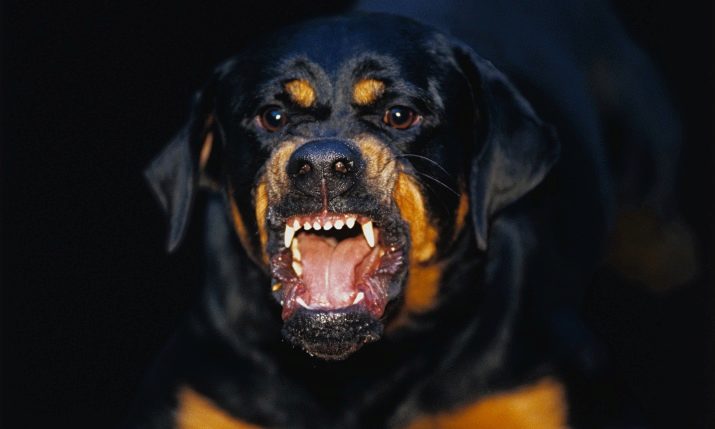
Generally, rashness is not characteristic of this breed, but good manners do not come naturally. Like any service dog, the Rottweiler needs training. Otherwise, obedience is out of the question.
The high level of intelligence of a trained dog allows it not only to be a guard at home, but also to become a companion. This animal will never go on about the desired profit due to the clear division of prerogatives. However, the disadvantage of these dogs can be called the laziness inherent in certain representatives of the breed. And if the owner ignores the rules of walking, the dog can become lazy. And this, as a rule, is fraught with health problems.
Rottweilers get along quite well with children, but leaving animals with babies without adults is unacceptable. Despite the fact that some breeders do not like their pets, you cannot completely trust Rottweilers. Firstly, it is necessary to understand that even a friendly dog is strong by nature and may not calculate its strength, causing harm to the child when playing, and secondly, if the situation in the family is unstable and frequent quarrels in raised tones, it is impossible to leave the dog with the child.
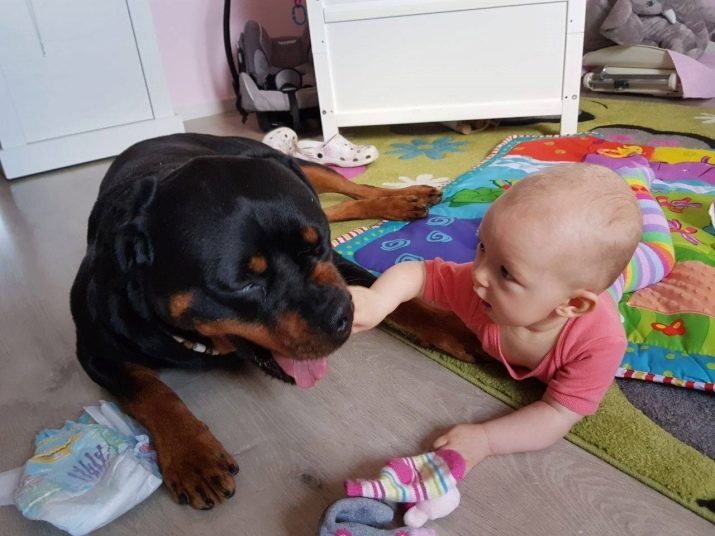
If peace and love reign at home, the dog absorbs such an attitude from puppyhood like a sponge, becoming peaceful.
There are cases when the appearance of small children as guests in the house of the dog was well received. In this case, the animal, as a rule, pays attention to the attitude of the owners towards the guests. Some trained pets are waiting for the owners to invite them to get acquainted, and therefore they can maintain their distance, looking with curiosity at the baby from the next room or the corridor of the dwelling.
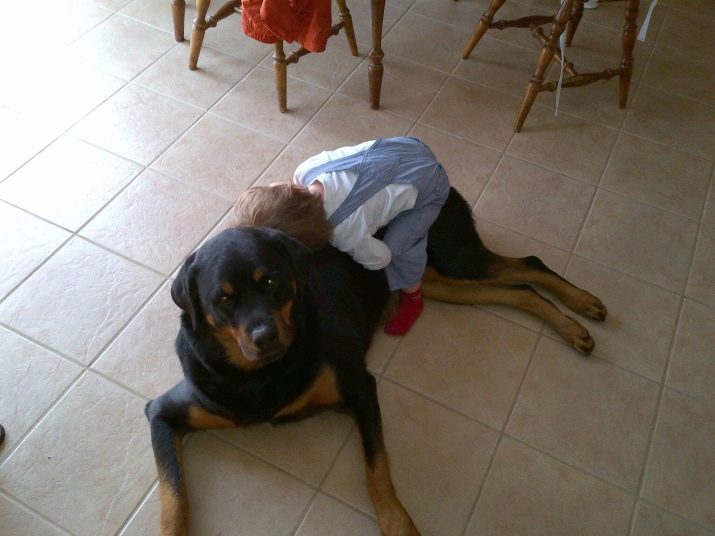
Degrees of aggressiveness
The Rottweiler is considered a controversial but outstanding dog. Its characteristic qualities are based on a tendency to show aggression. From a cynological point of view, the degree of aggressiveness can be classified into several types, and some of them are considered not negative, but positive, since they do not create problems. For example, aggressiveness towards dogs is rare in Rottweilers, while in other breeds this trait is pronounced. However, if there is such a thing, then this is the result of improper upbringing.
Aggression towards humans from the total number of Rottweilers is no more than 16.7% of the surveyed animals. This indicator is higher than that of indoor and more friendly counterparts. As for the attitude towards children, everything here also depends on the upbringing of the dog: she often adores her own, but perceives strangers in different ways.
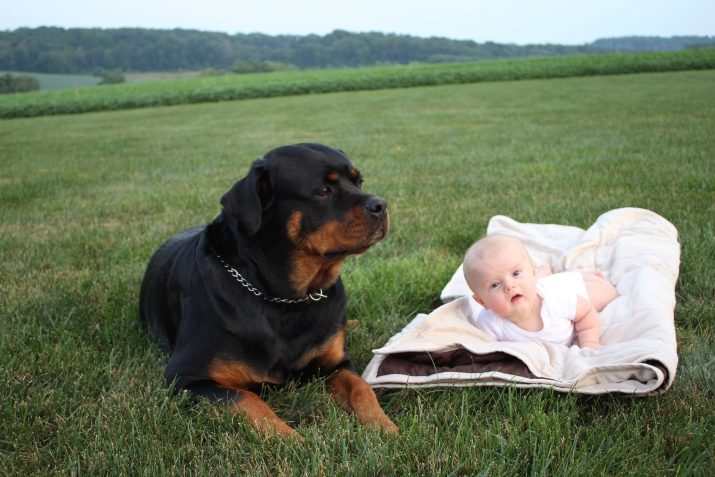
Studies show that most Rottweilers do not like other children.
Host aggression is not common for a Rottweiler. However, under certain conditions in the house, about 12% of dogs are capable of this. Aggressiveness towards household members can be expressed in disobedience or resistance to their actions, loud barking. In addition, aggressive behavior can include growling and biting towards those who try to control the animal against its will.
As practice shows, in our country, these indicators prove the incorrect training of Rottweilers. Almost half of the dogs allow themselves to do this (slightly more than 50%). At the same time, the degree of aggressiveness towards others in educated animals usually does not exceed 12-15%. At the same time, most breeders are always sure that their pet is peaceful, and those who it attacks are to blame.
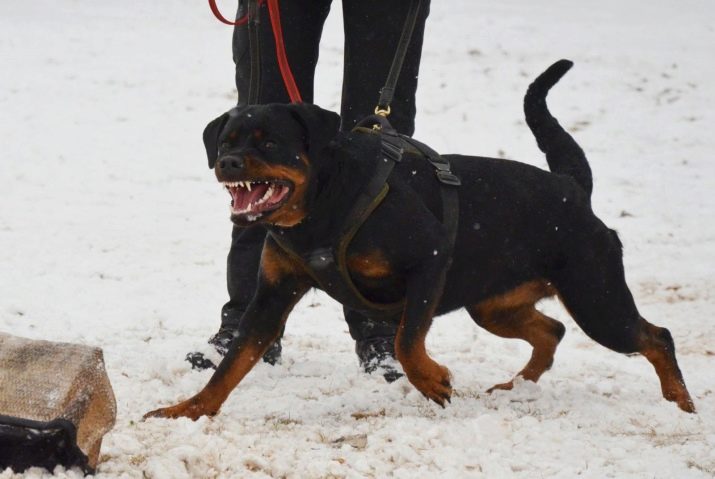
It is difficult for such people to prove otherwise, even if their pet tears a stranger to pieces.
Aggression in defense is often associated with protective qualities, and they are much better developed in Rottweilers than in many other canine brethren. Sentinel qualities are pronounced in half of the available livestock. These dogs are able to detect approaching strangers and notify the owner of them with loud barking.
Almost all Rottweilers carry out the protection of the territory, however, the tendency to empty barking for no reason is not characteristic of these dogs. Only a few representatives of the breed allow themselves to bark idle, although this is almost always suppressed by the owner.
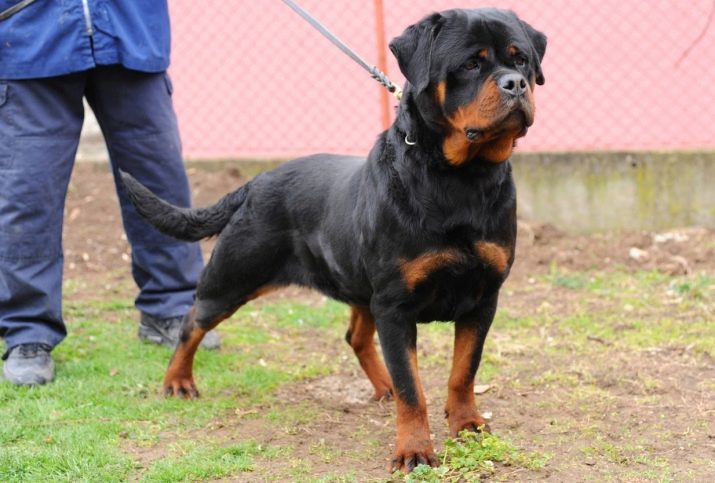
How to choose a puppy?
When choosing a puppy, you need to consider the level of experience of the breeder. For example, if he is inexperienced, it is better to choose a girl puppy, because, as practice shows, the character of Rottweiler bitches is softer than that of males. In addition, it will be possible to quickly train them in the necessary commands. but when choosing, it is worth considering the fact that the bitches of this breed do not tolerate other females near them.
Males are distinguished by a more presentable appearance, but their mentor should be a man who is ready not only for an agreeable character, but also for the need to correct behavior... You need to take a puppy no later than the age of 2-3 months. At 2 months old, puppies already have the first experience of socialization, until they show stubbornness and learn better. The age of the bitch who gave birth to the puppy must not be less than 2 years old and more than 8.
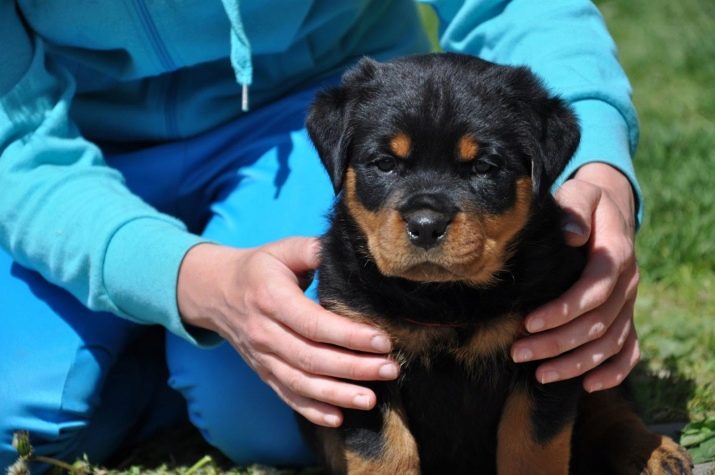
When buying, you need to demand from the seller an X-ray of the limbs of the puppy's parents. This will eliminate the likelihood of hereditary joint dysplasia.
In addition, you need to pay attention to the degree of activity of the puppy, its neatness and color. At the same time, it is necessary to choose the baby whose tan marks are darker, because after the first molt, his fur coat may brighten. As practice shows, more hardy and strong dogs grow from puppies with a darker color.
When examining, you need to pay attention to the puppy's abdomen in order to exclude the possibility of an umbilical hernia. All dewclaws in pedigree puppies are cropped. If the puppy is too aggressive, this is a vice, you cannot buy such a dog. When buying, you can test the puppy by ringing the bell or clapping your hands: the cowardly kid will run away, while the curious and confident will take an interest.
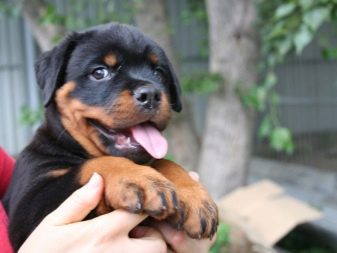

The cost of a puppy will depend on several factors.
For example, this is a pedigree with several generations of ancestors, exhibition perspectives, conformity to the exterior, the presence of titles from the parents. Defective dogs, which usually try to sell to inexperienced buyers, will have a low price. The cost of a good baby, which can be used for breeding, in a professional nursery will be about 30,000 rubles.

Maintenance and care
Rottweilers are well trained and quickly understand the order in the house. Most puppies, getting into a new home from the kennel, after a couple of weeks understand and accept the rules that are established for everyone. They do not gnaw on shoes, do not tear the wallpaper, and do not consider an apartment or a house a street where a lot of freedom is allowed.
However, a considerable part of breeders, after a puppy's stay in the house for some time, begin to be disappointed in him. The reason lies in the fact that the breeder is not ready for the maintenance and education of a Rottweiler or overestimated his educational capabilities.
You need to bathe the Rottweiler no more than twice a year and as it is heavily soiled (for example, if the dog came in dirty from a walk after the rain). For washing, it is better to use special detergents designed specifically for dogs.


The paws should be washed after every walk.
You need to comb your pet's coat about twice a week. During the shedding period, it is necessary to rid the Rottweiler of dead wool every day. Some pets even allow themselves to be vacuumed, but accustoming to this procedure must begin from puppyhood.
Rottweilers' teeth are cleaned with special sticks or brushes and zoos, purchasing the necessary items in specialized stores for animals. The eyes are examined constantly, if redness or inflammation is found, they consult a doctor.
This dog can live both in his house and in an apartment. However, ideally, this dog needs a private or country house with an aviary for a comfortable stay. You need to walk an animal living in an apartment at least twice a day for an hour and a half. In addition, it is necessary to take the dog to the toilet as needed.
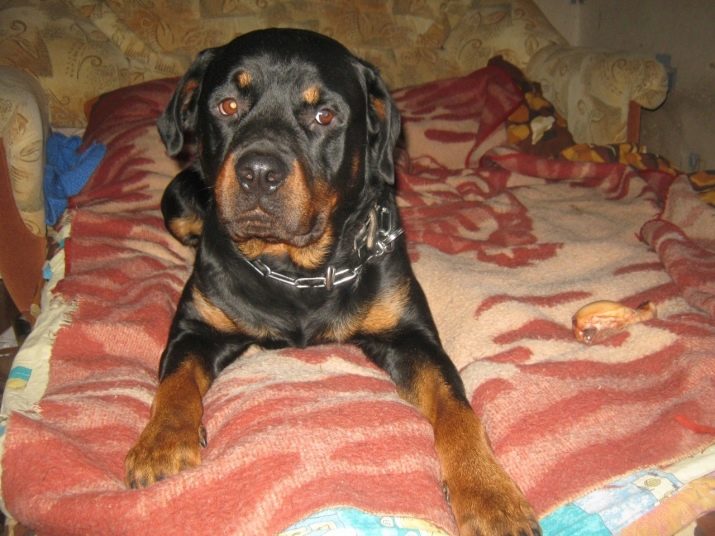
A Rottweiler should have a place in the house.
In no case should you share the same piece of furniture with him, in the future the dog will consider the sofa, bed or armchair its place. And therefore, she can perceive the attempts of household members to sit on them negatively. By the way, the puppy should have its own place from the first day in the house after the purchase. This is the first rule that he must learn and accept.
Considering that the claw plates of active Rottweilers grind off on their own, it is not always necessary to trim their claws. However, examination of the paw pads should be done on a continuous basis, as should the examination of the ears, eyes, and oral hygiene. After a walk, you need to examine the animal for the presence ticks or fleas... If they are found, it is necessary to urgently contact the veterinarian to solve the problem.

The ears of the dog are cleaned about once a week, and for dogs with docked ears, more often, ridding them of accumulated wax and dirt.
To do this, use scraps of cloth, moistening them in a special lotion that does not contain alcohol. If an unpleasant odor or inflammation is found, the dog is immediately taken to a specialist. When cleaning your ears, do not use cotton pads or cotton swabs.
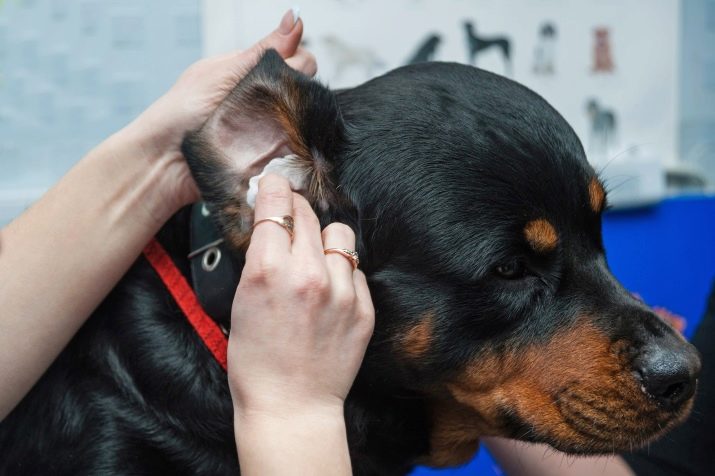
Feeding
The Rottweiler's diet can be different. For example, the basis of feeding can be chosen natural or industrial food. At the same time, in addition to dry granulated food, the dog can buy canned food. Each feeding scheme has its own nuances, but any food should be balanced and varied, as well as of high quality. One or another option is chosen taking into account the age and degree of activity of the animal, as well as the presence of the necessary vitamins and trace elements in the feed.
The good thing about commercial feed is that it saves cooking time. It is balanced, concentrated. This means that it is needed for feeding less than natural food. In addition, pelleted feed is sold in packages that indicate dosage, which is very convenient for the breeder.
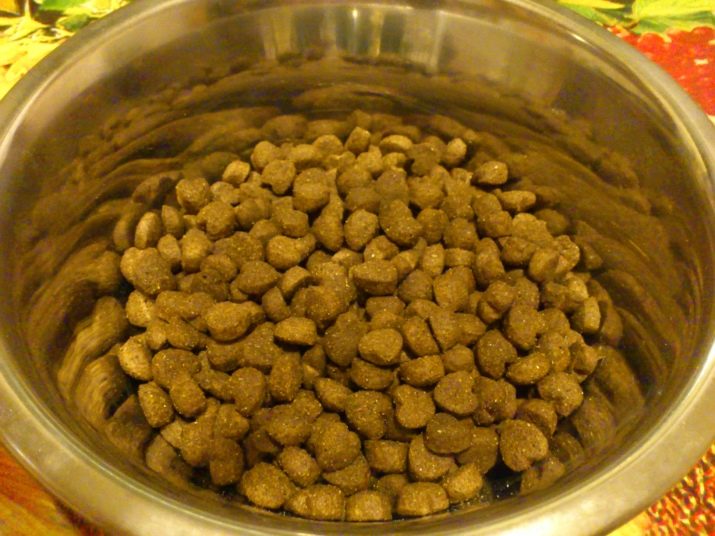
The size of the granules is selected taking into account the age of the pet, because the puppy, for example, is not able to gnaw large hard granules, this is harmful to his teeth.
If a decision is made to feed the dog with natural food, in addition to it, you have to purchase special vitamin complexes for dogs, supplementing the diet with them. This food should be varied and always fresh. Must be given to the dog lean meat, for example, rabbit, lamb, lamb or beef. In addition, the animal needs offal, eggs, cottage cheese, cereals (buckwheat, rice, barley).
Also, vegetables and fruits should be present in the diet. Puppies can be given milk, but dogs may become lactose intolerant as they age. In addition to meat, you need to feed the Rottweiler with cartilage and bones, fillets of sea fish, vegetable oil. Do not give your dog legumes, sweets and chocolates, sausages, sausages, tubular bones, pork and citrus fruits.


The water should be fresh, the food should be warm (from hot Rottweilers develop gastritis).
You cannot overfeed your pet, as dogs of this breed may tend to be obese. If the pet has acquired gastrointestinal diseases, it is necessary to revise the diet., because with age, this can develop into problems with the genitourinary system.
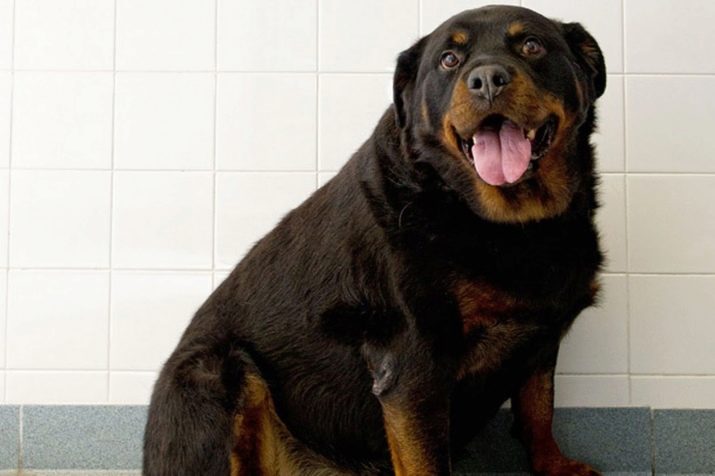
Education and training
Rottweilers are considered intelligent and quick-witted animals. In addition, they have an inherent cunning that they can use when teaching. Their teacher must know every character trait of a particular dog, this is the only way to make it educated and intelligent.During training, a pet may suddenly stop fulfilling a specific command, look at its teacher with an incomprehensible look. Such a deception does not work with experienced dog handlers, but a novice breeder can be confused.
A dog without training and education is like a grenade that can explode at any moment. The animal quickly realizes its strength and can take a dominant position, becoming a home dictator for all household members. You need to train him from childhood, referring to a professional dog handler. Usually, a specialist does not have any difficulties with training a Rottweiler, while an inexperienced owner in this matter can fail.

Socialization of the pet should occur as early as possible, and this will have to devote a lot of time and effort.
Rottweilers can be turned on only by strong-willed individuals who are responsible for everything and are distinguished by their firmness of character. The first lessons can be entrusted to the dog handlerwho knows how to properly train these dogs. Typically, the teaching attitude is based on a calm and confident attitude towards the animal, friendliness and explanation.
From childhood, the Rottweiler is taught how to behave when guests or friends come to the house. He is taught the norms of behavior and a clear separation of situations when protection is needed and when it is not needed. This is not a chain dog: in order for it to become intelligent and loyal, the breeder will have to communicate with it a lot, including talking and playing. Considering that the Rottweiler's jaws are stronger than those of a pit bull or a German shepherd and that when bitten, their pressure is about 22 atmospheres, you will have to spend a lot of effort on forming the animal's attitude towards strangers.

Rottweiler training must be associated with feasible physical activity, running, movement and overcoming various kinds of obstacles.
Without proper physical activity, these dogs cannot develop normally, as well as without discipline. A trained dog is able to adapt to the life rhythm of the owner, as well as his habits. However, of all family members, the dog can single out the one who does it more than others.
So that dog's stubbornness does not interfere with training and education, the animal educator must be persistent and patient. Rottweilers memorize teams well, and their number may be greater than that of fellow breeds. However, when teaching, it is necessary not to forget about the sequence of actions, consolidation of the material studied, as well as the correct use of rewards.
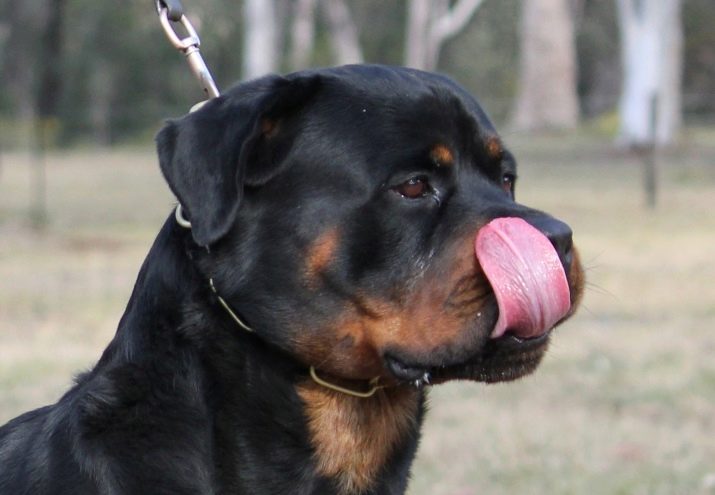
Training can be directed to different channels, for example, not only for protection, but also for hunting, escorting the owner, grazing.
Despite the fact that during the training process it is necessary to be firm in the requirements, you cannot put pressure on the dog. It should take a lot of time for classes, and any attempts at aggression and spitefulness should be stopped immediately. You cannot allow yourself to be physically punished for not following commands, you must not allow yourself to be weak in training, the dog must perceive the educator as a leader. At the same time, training should be energetic and varied.
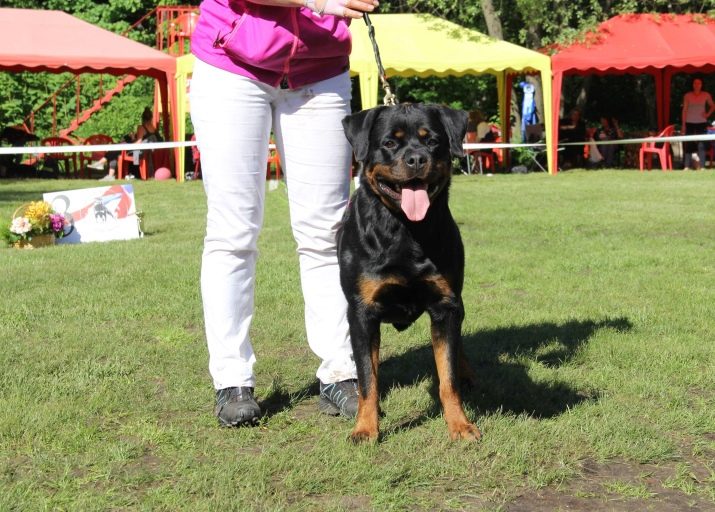
List of nicknames
The name of the Rottweiler must be chosen in accordance with the status of his breed. Therefore, nicknames in the spirit of Sharik, Tuzik, Druzhok, Polkan are not suitable here. At the same time, there is no need to invent kilometer-long nicknames: this is not only ugly, but also inappropriate. The name should be small, harsh and nice-sounding... The soft pronunciation typical of cat names is inappropriate here.
For example, a boy Rottweiler can be presented with a name:
- Brutus;
- North;
- Tyson;
- Schwartz;
- Ram;
- Charon;
- Drago;
- Jag;
- Turvon;
- Stark;
- Kaiser;
- Hugo;
- Oscar.

For a Rottweiler girl, you can choose the following name:
- Nora;
- Irma;
- Greta;
- Alba;
- Bella;
- Isa;
- Hell;
- Bruna;
- Karna;
- Amber;
- Noemi;
- Grace;
- Gina;
- Daisy;
- Wendy.
When choosing a nickname, it is necessary to take into account the fact that it should not be consonant with the command pronounced by the owner or the dog handler.In addition, the name should not be racist, offensive, or downright stupid (e.g. Ghoul, Dumb, Damn). You should not give the Rottweiler a nickname by the name of household members or their relatives, friends and acquaintances.

An ideal nickname would be an abbreviated nickname from the one chosen for the pedigree (for example, Rott from Rottenberg).
Owner reviews
Most of the owners of Rottweilers consider them excellent companions, best friends of all household members. This is evidenced by the reviews of breeders left on information portals. According to the owners, Rottweilers are active, strong and strong-willed animals. Experienced dog breeders are sure that it is necessary to spend a lot of time with them, but the time is more than pays off with the dedication and loyalty of the animals.
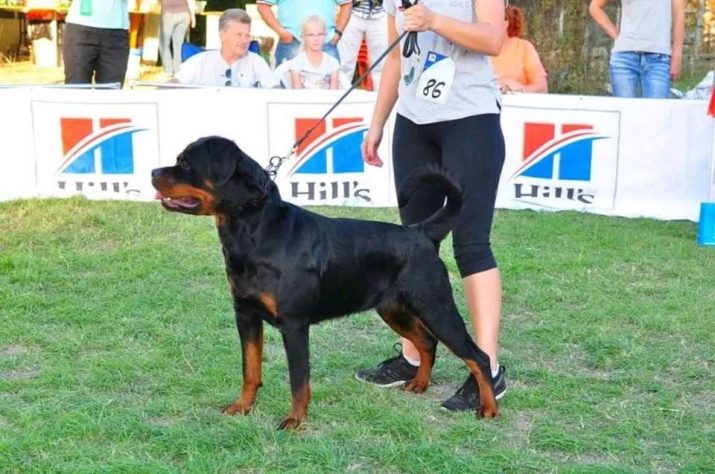
In families, these animals behave differently. Some of them, for example, are loved not only by family members at home, but also by all their guests. At the same time, dogs allow themselves to be stroked, combed, they gladly ride children on sleds and love jogging with a sports owner. Some Rottweilers recognize as their own and relatives who stay in the house for a long time.
It is noteworthy that dogs living in an apartment and behaving calmly on the street can perceive the entrance as their territory. And therefore, everyone who is seen on it, they frighten by barking or roaring (if they are muzzled).
For the problems that arise with Rottweilers, see below.



































